<net>
.

photo
: eugenie nable
outdoor site action / installation -- 10 May, 2002
Malham Cove cliffs = Yorkshire Dales National Park
outdoor site action / installation -- 10 May, 2002
Malham Cove cliffs = Yorkshire Dales National Park
.
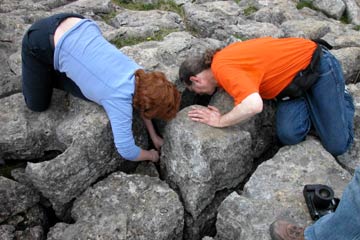 |
|
TRAIL
magazine writer, Maria del Carmen Clegg, and Steve Bradley searching
out deposited garbage stuffed deep into naturally formed crevasses
on top of Malham Cove near the town of Skipton, England. Eugenie,
Tom (photographer), Maria and myself collected rubbish presumably
left behind by visitors hiking into the region; students of geography,
site seers, and mountain climbers.
|
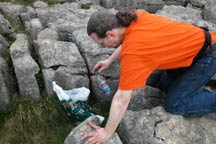 |
We suspended a net between three trees and staked the fourth corner to the ground. We then attached the rubbish onto the net beginning at the highest points on the net. creating in the end a vortex shape with the found debris. The idea is to represent the rubbish at one given area at eye level to the unsuspecting viewer. The shape that is created is a whirlwind of rubbish between three trees supporting the structure.
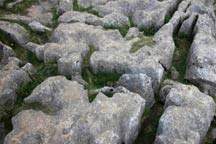 |
|
limestone
pavement top of Malham Cove
|
The age of the garbage ranged from two years to as recent as the week before our action. We dated the material through expiration and purchase dates found on discarded food containers and receipts. There is a particular form of debris that has been folded obsessively into a triangle or knot. These items are often candy wrappers or crisp bags. I call this behavior “pre-litter anxiety,” because the behavior consists of not being able to discard the waste until much later after consuming the contents. This behavior can result in a cigarette package obsessively twisted until it retains a screw pattern. Sometimes the most creative forms of “pre-litter anxiety” disposal of rubbish are wrappers that have been folded into an origami like structures; triangles, squares, and knots that resemble a bow tie.
consumer behavior:
The material found was often crumpled, carefully folded, smashed and deposited into holes between the stones of the roadside walls. Other sites where rubbish was found tucked “away” or hidden were spaces among the deep into limestone crevasses found on top of Malham Cove. My assumption is that the visitor is hiding or trying to cover up the act of littering. I observed a number of similar kinds of behavior found in cities through my travels in Hull, London, York, England; Amsterdam and Maastricht, Holland, and Schwabisch Hall, Germany.
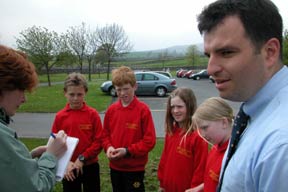 |
|
Maria
del Carmen Clegg intervieing Michael Thwaite, Elliott Leek, Lucy
Parkin,
Judie Bollan and their head master teacher, Richard Wright. |
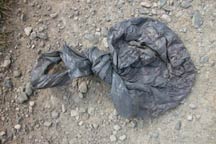 |
|
small plastic bag full of animal or human feces |
We collected whatever we could find at three primary sites; the trail, base of the Malham Cove and Yorkshire National Park visitor center. The following items were found; cigarette butts, wrappers, plastic bags; beer, water, soda drink bottles and cans; crisps [junk food] wrappers; pens, pencils, large clip board clamp; smaller sorts of packaging which included candy, gum, tea, tea bags, expended fire works, large plastic feed bag, work gloves, wood scraps with industrial glue, unidentified plastic parts, party balloons with ribbons, broken yellow plastic coffee cup, drinking straws, breath mint plastic container, clothing; one sock and beanie wool hat, black comb, broken rubber suction cups, several pieces of paper with hand writing, tennis ball. We also collected unidentified debris fragments consisting of soft/hard plastic and paper. Several items we did not pick up were: a small gray bag of what appeared to be dog feces and tissues with human waste; vomit on blue/green paper towels; and climbing hardware still scatted and attached to the face of Malham Cove.
 |
|
Lucy
Parkin, Michael Thwaite,
Elliott Leek, Judie Bolland |
participants:
Collaborative effort with Maria del Carmen Clegg, Eugenie Nable,
Steve Bradley, Tom Bailey, photographer and four students from Kirby
in Malhamdale United Primary School, Lucy Parkin, Michael Thwaite,
Elliott Leek, Judie Bolland and their teacher Richard Wright, headmaster.
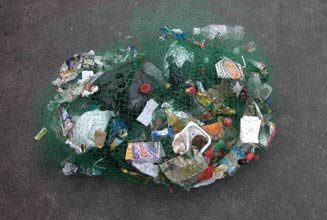 |
|
all the rubbish rolled up into a 'net ball' after deinstallation and deposited in the Peterbourgh, landfill. |